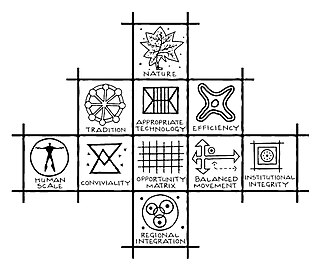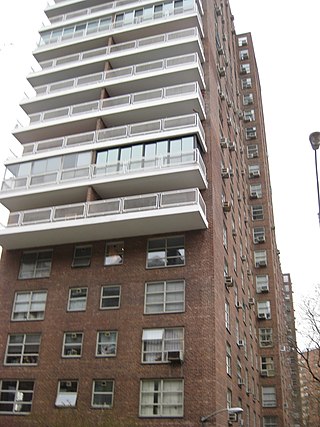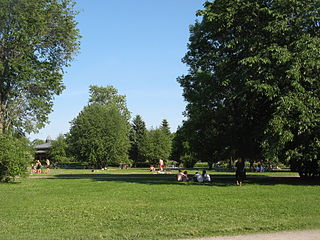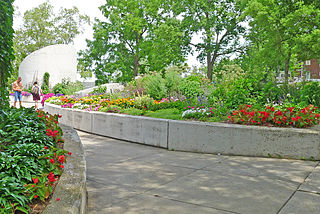
An assisted living residence or assisted living facility (ALF) is a housing facility for people with disabilities or for adults who cannot or who choose not to live independently. The term is popular in the United States. Still, the setting is similar to a retirement home, in the sense that facilities provide a group living environment and typically cater to an older adult population. There is also Caribbean assisted living, which offers a similar service in a resort-like environment.

Fripp Island is a 6.546 sq mi (16.954 km2) barrier island and census-designated place (CDP) located along the Atlantic coast of the lowcountry part of South Carolina. It was first listed as a CDP in the 2020 census with a population of 963.

Illegal dumping, also called fly dumping or fly tipping (UK), is the dumping of waste illegally instead of using an authorised method such as curbside collection or using an authorised rubbish dump. It is the illegal deposit of any waste onto land, including waste dumped or tipped on a site with no licence to accept waste.

Disaster response refers to the actions taken directly before, during, or immediately after a disaster. The objective is to save lives, ensure health and safety, and meet the subsistence needs of the people affected. It includes warning and evacuation, search and rescue, providing immediate assistance, assessing damage, continuing assistance, and the immediate restoration or construction of infrastructure. An example of this would be building provisional storm drains or diversion dams. Emergency response aims to provide immediate help to keep people alive, improve their health and support their morale. It can involve specific but limited aid, such as helping refugees with transport, temporary shelter, and food. Or it can involve establishing semi-permanent settlements in camps and other locations. It may also involve initial repairs to damage to infrastructure, or diverting it.
A planned unit development (PUD) is a type of flexible, non-Euclidean zoning device that redefines the land uses allowed within a stated land area. PUDs consist of unitary site plans that promote the creation of open spaces, mixed-use housing and land uses, environmental preservation and sustainability, and development flexibility. Areas rezoned as PUDs include building developments, designed groupings of both varied and compatible land uses—such as housing, recreation, commercial centers, and industrial parks—within one contained development or subdivision. Developed areas vary in size and by zoned uses, such as industrial, commercial, and residential. Other types of similar zoning devices include floating zones, overlay zones, special district zoning, performance-based codes, and transferable development rights.

Mixed use is a type of urban development, urban design, urban planning and/or a zoning classification that blends multiple uses, such as residential, commercial, cultural, institutional, or entertainment, into one space, where those functions are to some degree physically and functionally integrated, and that provides pedestrian connections. Mixed-use development may be applied to a single building, a block or neighborhood, or in zoning policy across an entire city or other administrative unit. These projects may be completed by a private developer, (quasi-)governmental agency, or a combination thereof. A mixed-use development may be a new construction, reuse of an existing building or brownfield site, or a combination.

Principles of Intelligent Urbanism (PIU) is a theory of urban planning composed of a set of ten axioms intended to guide the formulation of city plans and urban designs. They are intended to reconcile and integrate diverse urban planning and management concerns. These axioms include environmental sustainability, heritage conservation, appropriate technology, infrastructure-efficiency, placemaking, social access, transit-oriented development, regional integration, human scale, and institutional integrity. The term was coined by Prof. Christopher Charles Benninger.
The defensible space theory of architect and city planner Oscar Newman encompasses ideas about crime prevention and neighborhood safety. Newman argues that architectural and environmental design plays a crucial part in increasing or reducing criminality. The theory developed in the early 1970s, and he wrote his first book on the topic, Defensible Space, in 1972. The book contains a study from New York that pointed out that higher crime rate existed in high-rise housing projects than in low-rise complexes. This, he concluded, was because residents felt no control or personal responsibility for an area occupied by so many people. Throughout his study, Newman focused on explaining his ideas on social control, crime prevention, and public health in relation to community design.

Green infrastructure or blue-green infrastructure refers to a network that provides the “ingredients” for solving urban and climatic challenges by building with nature. The main components of this approach include stormwater management, climate adaptation, the reduction of heat stress, increasing biodiversity, food production, better air quality, sustainable energy production, clean water, and healthy soils, as well as more anthropocentric functions, such as increased quality of life through recreation and the provision of shade and shelter in and around towns and cities. Green infrastructure also serves to provide an ecological framework for social, economic, and environmental health of the surroundings. More recently scholars and activists have also called for green infrastructure that promotes social inclusion and equity rather than reinforcing pre-existing structures of unequal access to nature-based services.

Morningside Gardens is a private housing cooperative operated by Morningside Heights Housing Corporation (MHHC) in Morningside Heights, Manhattan, New York City. It is composed of a parking garage and six apartment buildings of 21 stories each, for a total of about 980 apartments. MHHC rents space to the Children's Learning Center preschool and the Morningside Retirement and Health Service. The complex has many amenities for its cooperators including a playground, a fitness center, storage units, indoor play spaces for children and young adults, bike rooms, and a workshop including ceramics and woodworking.
Waste management in Japan today emphasizes not just the efficient and sanitary collection of waste, but also reduction in waste produced and recycling of waste when possible. This has been influenced by its history, particularly periods of significant economic expansion, as well as its geography as a mountainous country with limited space for landfills. Important forms of waste disposal include incineration, recycling and, to a smaller extent, landfills and land reclamation. Although Japan has made progress since the 1990s in reducing waste produced and encouraging recycling, there is still further progress to be made in reducing reliance on incinerators and the garbage sent to landfills. Challenges also exist in the processing of electronic waste and debris left after natural disasters.

In land-use planning, urban green space is open-space areas reserved for parks and other "green spaces", including plant life, water features - also referred to as blue spaces - and other kinds of natural environment. Most urban open spaces are green spaces, but occasionally include other kinds of open areas. The landscape of urban open spaces can range from playing fields to highly maintained environments to relatively natural landscapes.

Land recycling is the reuse of abandoned, vacant, or underused properties for redevelopment or repurposing.

Arbutus Ridge Seaside Community for Active Adults is an age-qualified, gated community located on the southeastern coast of Vancouver Island in the Cobble Hill Electoral Area of British Columbia's Cowichan Valley Regional District. "Arbutus Ridge was the first comprehensive retirement community built in Canada and it subsequently became the template and proving ground for what has become recognized as an accepted and commonplace age-specific form of housing." Even though the community was incorporated in 1987, it was not until 2018 that the Province of British Columbia approved the adoption of the name "Arbutus Ridge" as the official name for the community.
A fenceline community or frontline community is a neighborhood that is immediately adjacent to a company, military base, industrial or service center and is directly affected by the noise, odors, chemical emissions, traffic, parking, or operations of the company. These communities are exposed to hazardous chemicals, high pollution levels, and environmental degradation along with the threat of chemical explosions.
Technical aspects of urban planning involve the technical processes, considerations and features that are involved in planning for land use, urban design, natural resources, transportation, and infrastructure.

Fecal sludge management (FSM) is the storage, collection, transport, treatment and safe end use or disposal of fecal sludge. Together, the collection, transport, treatment and end use of fecal sludge constitute the "value chain" or "service chain" of fecal sludge management. Fecal sludge is defined very broadly as what accumulates in onsite sanitation systems and specifically is not transported through a sewer. It is composed of human excreta, but also anything else that may go into an onsite containment technology, such as flushwater, cleansing materials, menstrual hygiene products, grey water, and solid waste. Fecal sludge that is removed from septic tanks is called septage.

Co-living is a residential community living model that accommodates three or more biologically unrelated people living in the same dwelling unit. Generally co-living is a type of intentional community that provides shared housing for people with similar values or intentions. The co-living experience may simply include group discussions in common areas or weekly meals, although will oftentimes extend to shared workspace and collective endeavors such as living more sustainably. An increasing number of people across the world are turning to co-living in order to unlock the same benefits as other communal living models, including "comfort, affordability, and a greater sense of social belonging."

Urban ecotourism is a relatively new form of ecotourism that takes place in urban settings. The concept first appeared in 1996 when the Blackstone Corporation defined it as “[...] travel and exploration within and around an urban area that offers visitors enjoyment and appreciation of the city's natural areas and cultural resources, [...] promotes the city's long-term ecological health [...] promotes sustainable local economic and community development and vitality; [...] is accessible and equitable to all”. Urban ecotourism shares the same goals for sustainability and community development as traditional ecotourism, but applies them to large cities, industrial wastelands, and post-productivist agriculture sites, as opposed to more nature-based venues for traditional ecotourism. Destinations in these locations may take the form of linear parks, farm-to-table restaurants, rewilding parks, biking and hiking trails, sustainable hotels, and rooftop gardens.
Environmental racism is a form of institutional racism, in which people of colour bear a disproportionate burden of environmental harms, such as pollution from hazardous waste disposal and the effects of natural disasters. Environmental racism exposes Native Americans, African Americans, Asian Americans, Pacific Islanders, and Hispanic populations to physical health hazards and may negatively impact mental health. It creates disparities in many different spheres of life, such as transportation, housing, and economic opportunity.













